Page 56:
Try answering the questions below and share your reasoning:
1. Can the children rearrange themselves so that the children standing at the ends say ‘2’?
Answer:
No,the children cannot rearrange themselves so that the children standing at the ends say ‘2’. A child says ‘2’ if both the neighbours standing next to them are taller. The children standing at the ends have only one neighbour. Hence, the given situation is not possible.
2. Can we arrange the children in a line so that all would say only 0s?
Answer:
No, we cannot arrange the children in a line so that all would say only 0s. This situation is only possible if all the children are of equal heights. In this case, the children all have different heights.
3. Can two children standing next to each other say the same number?
Answer:
Yes, two children standing next to each other can say the same number if they are of same height and have taller children standing on the other side of them.
4. There are 5 children in a group, all of different heights. Can they stand such that four of them say ‘1’ and the last one says ‘0’? Why or why not?
Answer:
Yes, they can stand such that four of them say ‘1’ and the last one says ‘0’. The last one should have only one shorter neighbour standing next to them. Please refer to the girl on the right in Figure on Page 56 in the textbook for clarity.
5. For this group of 5 children, is the sequence 1, 1, 1, 1, 1 possible?
Answer:
No, for this group of 5 children, the sequence 1, 1, 1, 1, 1 is not possible. This is because even if you arrange the children in increasing or decreasing order of heights, there will be one child without any taller neighbours. Hence, the situation is not possible.
6. Is the sequence 0, 1, 2, 1, 0 possible? Why or why not?
Answer:
Yes, the sequence 0, 1, 2, 1, 0 is possible if the shortest child stands in the centre with two taller neighbours right next to them and the two tallest children at the two extreme ends.
7. How would you rearrange the five children so that the maximum number of children say ‘2’?
Answer:
We rearrange the five children so that the maximum number of children say ‘2’ in the following way: Among the three tallest children, two stand at the extreme ends and one stands in the middle. The second and fourth positions are occupied by the two shortest children. In this arrangement, the two shortest children can say ‘2’. The specific arrangement of the five children such that the maximum number of children say ‘2’ is shown below:
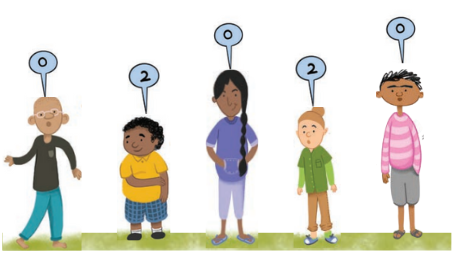
1. Colour or mark the supercells in the table below.

Answer:
The supercells in the table are marked below:

2. Fill the table below with only 4-digit numbers such that the supercells are exactly the coloured cells.

Answer: The table below is filled with only 4-digit numbers such that the supercells are exactly the coloured cells:

3. Fill the table below such that we get as many supercells as possible. Use numbers between 100 and 1000 without repetitions.

Answer:
The table below is filled with as many supercells as possible using numbers between 100 and 1000 without repetitions:

4. Out of the 9 numbers, how many supercells are there in the table above? ___________
Answer:
Out of the 9 numbers, how many supercells are there in the table above? 9
5. Find out how many supercells are possible for different numbers of cells.
Do you notice any pattern? What is the method to fill a given table to get the maximum number of supercells? Explore and share your strategy.
Answer:
Odd number of cells:
For an odd number of cells, an example is shown below:

There are 9 cells and 5 supercells among them. We note that (9 + 1/)/2 = 5. It can be found that for any odd number of cells n, the number of supercells = (n + 1)/2.
Even number of cells:
For an even number of cells, an example is shown below in two different ways possible:


For both cases, the number of cells = 10 and the number of supercells = 10/2 = 5.
It can be found that for any even number of cells n, the number of supercells = n/2.
6. Can you fill a supercell table without repeating numbers such that there are no supercells? Why or why not?
Answer:
No, you cannot fill a supercell table without repeating numbers such that there are no supercells. There will be at least one supercell in any arrangement. For clarity, refer to the example below:

The numbers have been arranged in ascending order and there is still one supercell at the right. This proves that at least one supercell will exist in any given arrangement.
7. Will the cell having the largest number in a table always be a supercell? Can the cell having the smallest number in a table be a supercell? Why or why not?
Answer:
Yes, the cell having the largest number in a table will always be a supercell because that is the definition of a supercell.
The slimmest number in a table can never be a supercell because the adjacent numbers will be greater.
8. Fill a table such that the cell having the second largest number is not a supercell.
Answer:
The table filled below has the second largest number 815 that is not a supercell:

9. Fill a table such that the cell having the second largest number is not a supercell but the second smallest number is a supercell. Is it possible?
Answer:
Yes, it is possible to fill a table such that the cell having the second largest number is not a supercell but the second smallest number is a supercell.

10. Make other variations of this puzzle and challenge your classmates.
Answer:
Another variation of this puzzle:
Table of three-digit numbers in which the largest number, the second largest number and the smallest number are all supercells.
The table can be as shown below:

Page 58:
Complete Table 2 with 5-digit numbers whose digits are ‘1’, ‘0’, ‘6’, ‘3’, and ‘9’ in some order. Only a coloured cell should have a number greater than all its neighbours.
The biggest number in the table is ____________.
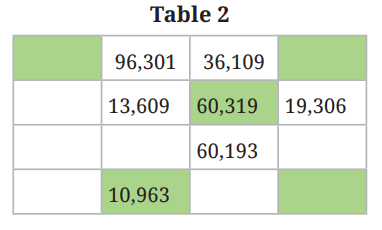
The smallest even number in the table is ____________.
The smallest number greater than 50,000 in the table is ____________.
Once you have filled the table above, put commas appropriately after the thousands digit.
Answer:
The completed Table 2with 5-digit numbers whose digits are ‘1’, ‘0’, ‘6’, ‘3’, and ‘9’ in some order and where only a coloured cell should have a number greater than all its neighbours is shown below:
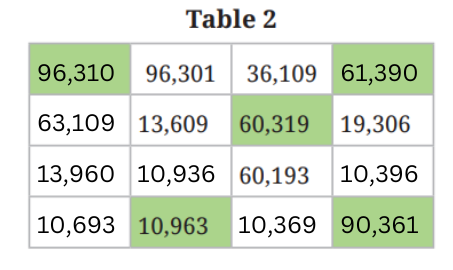
The biggest number in the table is 96,310.
The smallest even number in the table is 10,396.
The smallest number greater than 50,000 in the table is 60,319.
Once you have filled the table above, put commas appropriately after the thousands digit.
Page 59:
We are quite familiar with number lines now. Let’s see if we can place some numbers in their appropriate positions on the number line. Here are the numbers: 2180, 2754, 1500, 3600, 9950, 9590, 1050, 3050, 5030, 5300 and 8400.

Answer:

Figure it Out
Identify the numbers marked on the number lines below, and label the remaining positions.
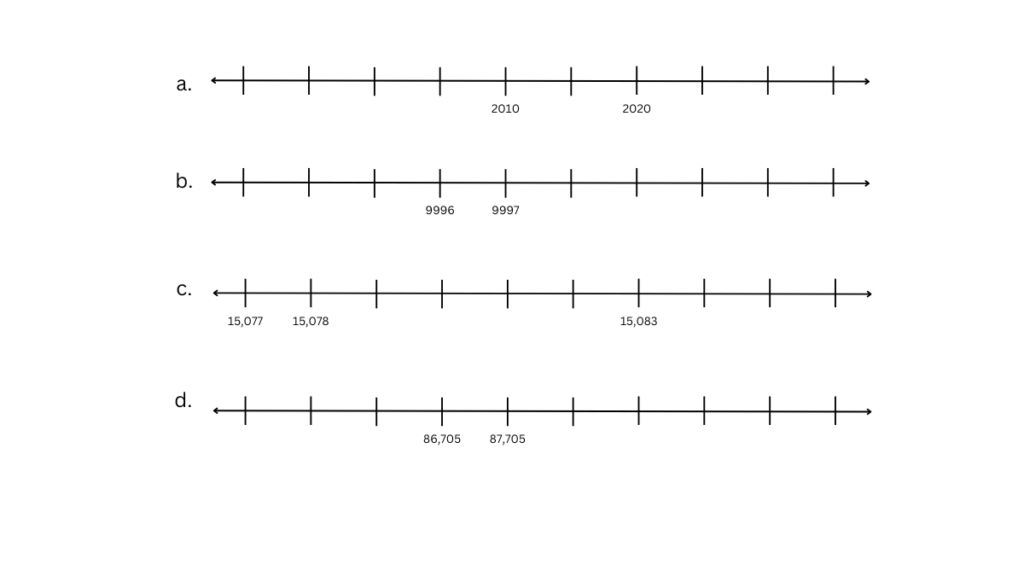
Put a circle around the smallest number and a box around the largest number in each of the sequences above.
Answer:
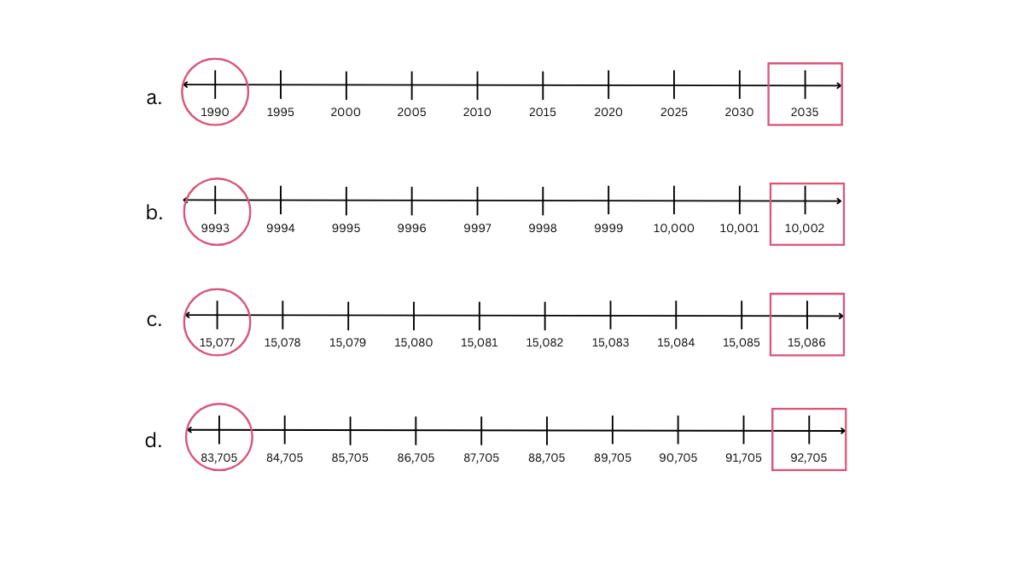
Page 60:
Find out how many numbers have two digits, three digits, four digits, and five digits:
| 1-digit numbers From 1–9 | 2-digit numbers | 3-digit numbers | 4-digit numbers | 5-digit numbers |
| 9 |
Answer:
| 1-digit numbers From 1–9 | 2-digit numbers | 3-digit numbers | 4-digit numbers | 5-digit numbers |
| 9 | 90 | 900 | 9000 | 90000 |
1. Two-Digit Numbers
The smallest two-digit number is 10.
The largest two-digit number is 99.
Total numbers: 99−10+1=90
2. Three-Digit Numbers
The smallest three-digit number is 100.
The largest three-digit number is 999.
Total numbers: 999−100+1=900
3. Four-Digit Numbers
The smallest four-digit number is 1000.
The largest four-digit number is 9999.
Total numbers: 9999−1000+1=9000
4. Five-Digit Numbers
The smallest five-digit number is 10000.
The largest five-digit number is 99999.
Total numbers: 99999−10000+1=90000
Figure it Out (Page 60):
1. Digit sum 14
a. Write other numbers whose digits add up to 14.
b. What is the smallest number whose digit sum is 14?
c. What is the largest 5-digit whose digit sum is 14?
d. How big a number can you form having the digit sum 14? Can you make an even bigger number?
Answer:
a. Write other numbers whose digits add up to 14.
Some other numbers whose digits add up to 14 are as follows:
1 + 9 + 4 = 14
5 + 5 + 4 = 14
11 + 2 + 1 = 14
10 + 4 = 14
12 + 2 = 14
13 + 1 = 14
7 + 7 = 14
b. What is the smallest number whose digit sum is 14?
We observe,
1 + 13 = 13
2 + 12 = 14
3 + 11 = 14
4 + 10 = 14
5 + 9 = 14
6 + 8 = 14
7 + 7 = 15
8 + 6 = 14
9 + 5 = 15
10 + 4 = 14
11 + 3 = 14
12 + 2 = 14
13 + 1 = 14
Out of all these sums, the sum 5 + 9 = 14 is of interest. The smallest number whose digit’s sum is 14 is 59.
c. What is the largest 5-digit whose digit sum is 14?
To get the largest 5-digit number, we start with the digit 9, followed by the digit 5 and fill the rest of the places with zeroes.
The largest five-digit number whosedigit sum is 14 is 95,000.
d. How big a number can you form having the digit sum 14? Can you make an even bigger number?
We can keep adding zeroes to the end of 14 consecutive 1’s to get bigger and bigger numbers as shown below:
11111111111111, 1111111111111100, 11111111111111000
000, and so on
Therefore, you can always make a bigger number having the digit sum 14.
2. Find out the digit sums of all the numbers from 40 to 70. Share your observations with the class.
Answer:
The digit sums of some of the numbers are shown below:
40 = 4 + 0 = 4
41 = 4 + 1 = 5
42 = 4 + 2 = 6
43 = 4 + 3 = 7
44 = 4 + 4 = 8
45 = 4 + 5 = 9
46 = 4 + 6 = 10
47 = 4 + 7 = 11
48 = 4 + 8 = 12
49 = 4 + 9 = 13
We leave the rest as an exercise for you to finish.
3. Calculate the digit sums of 3-digit numbers whose digits are consecutive (for example, 345). Do you see a pattern? Will this pattern continue?
Answer:
123 = 1 + 2 + 3 = 6
234 = 2 + 3 + 4 = 9
345 = 3 + 4 + 5 = 12
456 = 4 + 5 + 6 = 15
567 = 5 + 6 + 7 = 18
678 = 6 + 7 + 8 = 21
789 = 7 + 8 + 9 = 24
The pattern is consecutive multiples of 3 starting from 6.
This pattern cannot continue after 789 because the next digit after 9 is 10, which cannot give us a three-digit number.
In-text Questions (Page 61):
Among the numbers 1–100, how many times will the digit ‘7’ occur? Among the numbers 1–1000, how many times will the digit ‘7’ occur?
Answer:
Count the number of times the digit ‘7’ occurs from 1 to 100:
We count the number of times ‘7’ occurs in the tens place and units place separately.
(a) Units Place
Numbers where ‘7’ appears in the units place: 7, 17, 27, …,97
Total: 10 numbers.
(b) Tens Place
Numbers where ‘7’ appears in the tens place: 70, 71, 72, …, 79
Total: 10 numbers.
Total for 1–100 = 10 + 10 = 20
Step 2: Count occurrences of the digit ‘7’ from 1 to 1000
Here, we consider the hundreds place, tens place, and units place.
(a) Hundreds Place
Numbers where ‘7’ appears in the hundreds place: 700, 701, 702, …, 799
Total: 100 numbers.
(b) Tens Place
For each group of 100 numbers (0–99, 100–199, …, 900–999) ‘7’ appears in the tens place 10 times:
70–79,170–179, …, 970–979
Total: 10 × 10 = 100
(c) Units Place
Similarly, ‘7’ appears in the units place 10 times in each group of 100:
7, 17, 27,…, 97; 107, 117,…, 197; … ;907, 917, …,997
Total: 10 × 10 = 100 numbers.
Therefore,
Total for 1–1000
100 (hundreds place) + 100 (tens place) + 100 (units place) = 300 times.
In-text Questions (Page 61):
All palindromes using 1, 2, 3
The numbers 121, 313, 222 are some examples of palindromes using the digits ‘1’, ‘2’, 3’.
Write all possible 3-digit palindromes using these digits.
Answer:
All palindromes using 1, 2, 3 are 111, 121, 212, 222, 232, 313, 323, 333, 131.
Explore (Page 62):
Will reversing and adding numbers repeatedly, starting with a 2-digit number, always give a palindrome? Explore and find out.
Answer:
Steps to follow: Start with a 2-digit number. Add this number to its reverse. Stop if you get a palindrome; else repeat the steps of reversing the digits and adding.
Example 1:
Take 13 and the reverse 31.
13 + 31 = 44
44 is a palindrome.
Example 2:
Take 39 and the reverse 93.
39 + 93 = 132
Reverse of 132 = 231
132 + 231 = 363
363 is a palindrome.
Example 3:
Take 45 and the reverse 54.
45 + 54 = 99
Reverse of 99 is a palindrome.
All two-digit numbers eventually yield a palindrome.
Exception: For 3-digit numbers the answer is unknown. It is suspected that starting with 196 never yields a palindrome!
Puzzle time (Page 62):
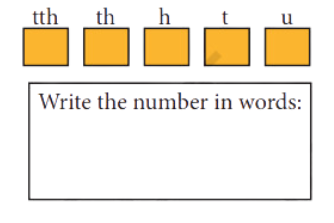
I am a 5-digit palindrome.
I am an odd number.
My ‘t’ digit is double of my ‘u’ digit.
My ‘h’ digit is double of my ‘t’ digit.
Who am I? _________________
Answer:
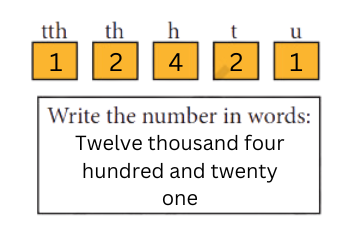
I am a 5-digit palindrome.
I am an odd number.
My ‘t’ digit is double of my ‘u’ digit.
My ‘h’ digit is double of my ‘t’ digit.
Who am I? 12421
Explore (Page 63):
Take different 4-digit numbers and try carrying out these steps. Find out what happens. Check with your friends what they got.
Follow these steps:
Step 1: Take a 4-digit number.
Step 2: Make the largest number from these digits. Call it A.
Step 3: Make the smallest number from these digits. Call it B.
Step 4: Subtract B from A. Call it C. C = A – B
Step 5: Continue doing this until you reach 6174.
First Example:
Take the number 5172.
First Try:
A = 7521
B = 1257
C = A – B = 7521 – 1257 = 6264
Second Try:
A = 6642
B = 2466
C = A – B = 6642 – 2466 = 4176
Third Try:
A = 7641
B = 1467
C = A – B = 7641 – 1467 = 6174
We have reached the magic number ‘6174’.
Second Example:
Take the number 8932.
First Try:
A = 9832
B = 2389
C = A – B = 9832 – 2389 = 7443
Second Try:
A = 7443
B = 3447
C = A – B = 7443 – 3447 = 3996
Third Try:
A = 9963
B = 3699
C = A – B = 9963 – 3699 = 6264
Fourth Try:
A = 6642
B = 2466
C = A – B = 6642 – 2466 = 4176
Fifth Try:
A = 7641
B = 1467
C = A – B = 7641 – 1467 = 6174
We have once again reached the magic number ‘6174’.
You will always reach the magic number ‘6174’! The number ‘6174’ is now called the ‘Kaprekar constant’.
In-text Questions (Page 64):
On the usual 12-hour clock, there are timings with different patterns. For example, 4:44, 10:10, 12:21.
Try and find out all possible times on a 12-hour clock of each of these types.
Answer:
1. Repeated Digits:
Times:
1:11, 2:22, 3:33, 4:44, 5:55, 6:00, 7:00, 8:00, 9:00, 10:10, 11:11, 12:22.
2. Symmetrical (Mirror) Digits:
Times:
1:01, 2:02, 3:03, 4:04, 5:05, 10:01, 11:11, 12:21.
Manish has his birthday on 20/12/2012 where the digits ‘2’, ‘0’, ‘1’, and ‘2’ repeat in that order.
Find some other dates of this form from the past.
Answer:
Some other dates of this form from the past are as follows:
12/02/1202, 20/12/2012, 10/12/1012, 19/12/1912, 14/12/1412, 11/12/1112
His sister Meghana has her birthday on 11/02/2011 where the digits read the same from left to right and from right to left.
Find all possible dates of this form from the past.
Answer:
Possible dates of this form from the past are as follows:
21/02/2012, 21/02/2012, 21/01/1012, 30/01/1003, 30/02/2003
You might have noticed that last year’s calendar was different from this year’s. Also, next year’s calendar is also different from the previous years.
But, will any year’s calendar repeat again after some years? Will all dates and days in a year match exactly with that of another year?
Answer:
Yes, a year’s calendar will repeat after some years when the days and dates align due to the 7-day week cycle and leap years. For regular years, the calendar repeats every 6 or 11 years, depending on the number of leap years in between. For leap years, the calendar typically repeats every 28 years.
Figure it Out (Page 24):
1. Pratibha uses the digits ‘4’, ‘7’, ‘3’ and ‘2’, and makes the smallest and largest 4-digit numbers with them: 2347 and 7432. The difference between these two numbers is 7432 – 2347 = 5085. The sum of these two numbers is 9779. Choose 4–digits to make:
a. the difference between the largest and smallest numbers greater than 5085.
b. the difference between the largest and smallest numbers less than 5085.
c. the sum of the largest and smallest numbers greater than 9779.
d. the sum of the largest and smallest numbers less than 9779.
Answer:
a. the difference between the largest and smallest numbers greater than 5085.
Let us take the digits 7, 8, 9, 1.
Largest 4-digit number with the digits 7, 8, 9, 1 = 9871.
Smallest 4-digit number with the digits 7, 8, 9, 1 = 1789.
The difference between these two numbers = 9871 – 1789 = 8082 which is greater than 5085.
b. the difference between the largest and smallest numbers less than 5085.
Let us take the digits 6, 2, 1, 0.
Largest 4-digit number with the digits 6, 2, 3, 0 = 6230.
Smallest 4-digit number with the digits 6, 2, 3, 0 = 2360.
The difference between these two numbers = 6230 – 2360 = 3870.
c. the sum of the largest and smallest numbers greater than 9779.
Let us take the digits 7, 8, 3, 2.
Largest 4-digit number with the digits 8, 7, 3, 2 = 8732.
Smallest 4-digit number with the digits 8, 7, 3, 2 = 2378.
The sum of the largest and smallest numbers = 8732 + 2378 = 1110 which is greater than 9779.
d. the sum of the largest and smallest numbers less than 9779.
Let us take the digits 2, 3, 1, 4.
Largest 4-digit number with the digits 2, 3, 1, 4 = 4321.
Smallest 4-digit number with the digits 1, 2, 3, 4 = 1234.
The sum of the largest and smallest numbers = 4321 + 1234 = 5555 which is less than 9779.
2. What is the sum of the smallest and largest 5-digit palindrome? What is their difference?
Answer:
The smallest 5-digit palindrome = 10001.
The largest 5-digit palindrome = 99999.
Sum = 10001 + 99999 = 110,000.
Difference = 99999 – 10001 = 89998.
3. The time now is 10:01. How many minutes until the clock shows the next palindromic time? What about the one after that?
Answer:
The time now is 10:01.
The next palindromic time is 11:11.
Therefore, it is 70 minutes until the clock shows the next palindromic time
The next palindromic time after 11:11 is 12:21.
4. How many rounds does the number 5683 take to reach the Kaprekar constant?
Answer:
Follow these steps:
Step 1: Take a 4-digit number.
Step 2: Make the largest number from these digits. Call it A.
Step 3: Make the smallest number from these digits. Call it B.
Step 4: Subtract B from A. Call it C. C = A – B
Step 5: Continue doing this until you reach 6174.
Number = 5683
First Try:
A = 8653
B = 3568
C = A – B = 8653 – 3568 = 5085
Second Try:
A = 8550
B = 558
C = A – B = 8550 – 558 = 7992
Third Try:
A = 9972
B = 2799
C = A – B = 9972 – 2799 = 7173
Fourth Try:
A = 7731
B = 1377
C = A – B = 7731 – 1377 = 6354
Fifth Try:
A = 6543
B = 3456
C = A – B = 6543 – 3456 = 3087
Sixth Try:
A = 8730
B = 3780
C = A – B = 8730 – 378 = 8352
Seventh Try:
A = 8532
B = 2358
C = A – B = 8532 – 2358 = 6174 (Kaprekar constant)
Therefore, it takes 7 tries to reach the Kaprekar constant.
In-text Questions (Page 66):
Can we make 1,000 using the numbers in the middle? Why not? What about 14,000, 15,000 and 16,000? Yes, it is possible. Explore how. What thousands cannot be made?
Answer:
It is not possible to make 1,000 using the numbers in the middle because 400, which is the only smaller number than 1000, cannot be added in different ways to form 1,000.
Yes, it is possible to make 14,000, 15,000 and 16,000 using 1,000 in the following ways:
14,000 = 13,000 + 1,000
15,000 = 13,000 + 2 × 1,000
16,000 = 13,000 + 3 × 1,000
Figure it Out (Page 66):
1. Write an example for each of the below scenarios whenever possible.
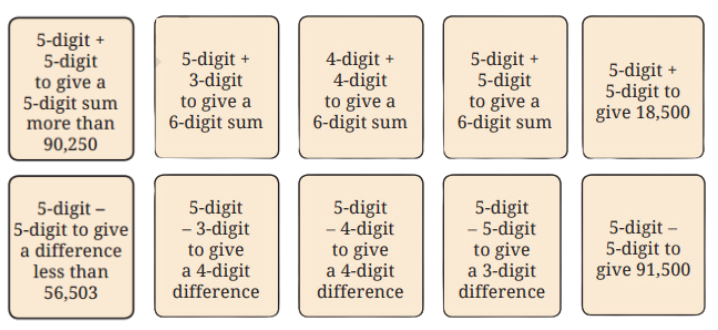
Could you find examples for all the cases? If not, think and discuss what could be the reason. Make other such questions and challenge your classmates.
Answer:
5-digit + 5-digit to give a 5-digit sum more than 90,250
First number = 70,000
Second number = 25,000
Sum = 70,000 + 25,000 = 95,000 which is greater than 90,250
5-digit + 3-digit to give a 6-digit sum
First number = 99,500
Second number = 600
Sum = 99,500 + 600 = 100,100 (6 digits)
4-digit + 4-digit to give a 6-digit sum
Not possible
Largest 4-digit number = 9999
9999 + 9999 = 19,998 (5 digits, not 6 digits)
5-digit + 5-digit to give a 6-digit sum
First number = 50,000
Second number = 50,000
Sum = 50,000 + 50,000 = 100,000 (6 digits)
5-digit + 5-digit to give 18,500
Not possible
The smallest possible 5-digit number = 10,000
Sum = 10,000 + 10,000 = 20,000 which is less than 18,500
5-digit – 5-digit to give a difference less than 56,503
First number = 90,000
Second number = 34,500
Difference = 90,000 – 34,500 = 55,500 which is less than 56,503
5-digit – 3-digit to give a 4-digit difference
First number = 10,000
Second number = 500
Difference = 10,000 – 500 = 9500 (4 digits)
5-digit − 4-digit to give a 4-digit difference
First number = 10,999
Second number = 1,999
Difference = 10,999 – 1,999 = 9000 (4 digits)
5-digit − 5-digit to give a 3-digit difference
First number = 99,900
Second number = 99,000
Difference = 99,900 – 99,000 = 900 (3 digits)
5-digit − 5-digit to give 91,500
Not possible.
Explanations: We take the largest 5-digit possible number which is 99,999. We have to subtract 8,499 from 99,999 to give 91,500. 8,499 is a 4-digit number.
More Questions:
a. 4-digit – 3-digit to give 3-digit difference
First number = 4,000
Second number = 3,500
Difference = 4,000 – 3,500 = 500 (3 digits)
b. 4-digit + 4-digit to give a 4-digit sum
First number = 4,000
Second number = 3,000
Sum = 4,000 + 3,000 = 7,000 (4 digits)
c. 6-digit + 6-digit to give 7-digit sum
First number = 950,000
Second number = 100,000
Sum = 950,000 + 100,000 = 1,050,000 (7-digits)
d. 5-digit – 3-digit to give 4-digit difference
First number = 10,000
Second number = 999
Difference = 10,000 – 999 = 9,001 (4-digits)
Here are some numbers arranged in some patterns. Find out the sum of the numbers in each of the below figures. Should we add them one by one or can we use a quicker way?
Share and discuss in class the different methods each of you used to solve these questions.
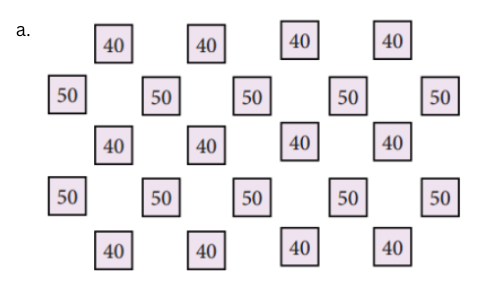
Answer:
Sum of numbers = 12 × 40 + 10 × 50 = 480 + 500 = 980
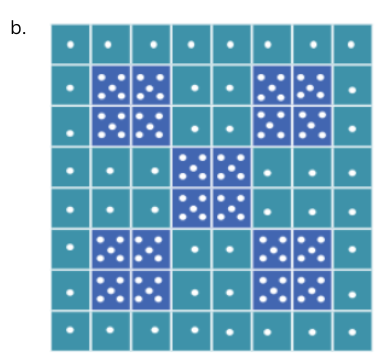
Sum of numbers = 44 × 1 + 20 × 5 = 144
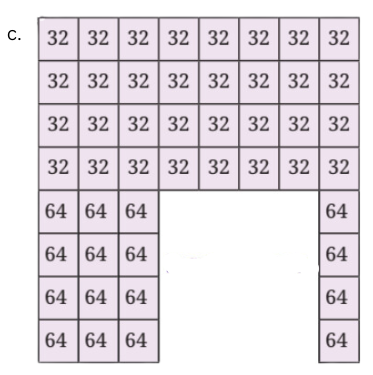
Sum of numbers = 32 × 32 + 16 × 64 = 1024 + 1024 = 2048
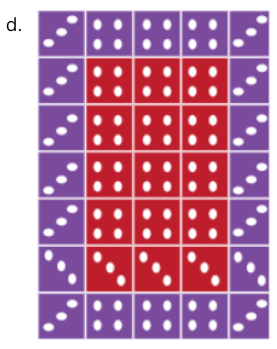
Sum of numbers = 17 × 3 + 18 × 4 = 51 + 72 = 123
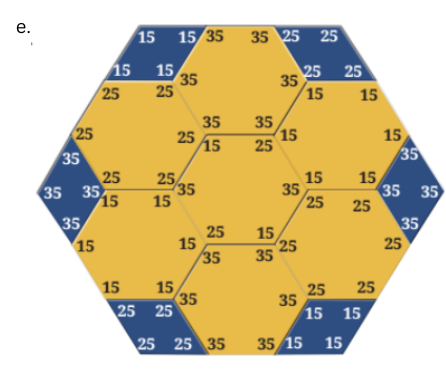
Sum of numbers = 22 × 15 + 22 × 25 + 22 × 35 = 1650
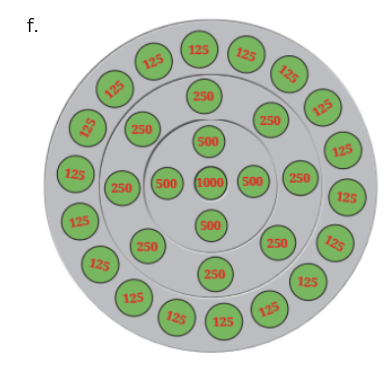
Sum of numbers = 18 × 125 + 8 × 250 + 4 × 500 + 1000 = 2250 + 2000 + 2000 + 1000 = 7250
In-text Questions (Page 69):
Make some more Collatz sequences like those above, starting with your favourite whole numbers. Do you always reach 1?
Do you believe the conjecture of Collatz that all such sequences will eventually reach 1? Why or why not?
Answer:
Some more Collatz sequences are shown below:
a. 16, 8, 4, 2, 1
b. 26, 13, 40, 20, 10, 5, 16, 8, 4, 2, 1
c. 20, 10, 5, 16, 8, 4, 2, 1
Figure it Out (Page 69):
We shall do some simple estimates. It is a fun exercise, and you may find it amusing to know the various numbers around us. Remember, we are not interested in the exact numbers for the following questions. Share your methods of estimation with the class.
1. Steps you would take to walk:
a. From the place you are sitting to the classroom door
b. Across the school ground from start to end
c. From your classroom door to the school gate
d. From your school to your home
Answer:
a. From the place you are sitting to the classroom door
When I walk normally, I take 10 steps from my seat to the classroom door.
b. Across the school ground from start to end
When I walk normally, I take 100 steps from start to end across the school ground.
c. From your classroom door to the school gate
When I walk normally, I take 200-225 steps from my classroom to the school gate.
d. From your school to your home
When I walk normally, it takes 2000 steps from my school to your home.
2. Number of times you blink your eyes or number of breaths you take:
a. In a minute
b. In an hour
c. In a day
Answer:
a. In a minute
In a minute I blink 12-15 times and take around 20 breaths in a minute.
b. In an hour
In a minute I blink 12-15 times.
Therefore, in an hour I blink 12 × 60 – 15 × 60 = 720 – 900.
In a minute I take 20 breaths.
Therefore, in an hour I breathe 20 × 60 = 1200 times.
c. In a day
In an hour I breathe 20 × 60 = 1200 times.
Therefore, in a day I blink 720 × 24 – 900 × 24 = 17,280 – 21,600 times.
In an hour I take 1200 breaths.
Therefore, in a day I breathe 1200 × 24 = 28,800 times.
3. Name some objects around you that are:
a. a few thousand in number
b. more than ten thousand in number
Answer:
a. a few thousand in number
Trees, buildings, cars.
b. more than ten thousand in number
Leaves on a single tree.
Grains of sand on a small beach.
Estimate the Answer (Page 70):
Try to guess within 30 seconds. Check your guess with your friends.
1. Number of words in your maths textbook:
a. More than 5000
b. Less than 5000
Answer:
a. More than 5000
Number of words in one line of my maths textbook = 9.
Number of lines in one page of my maths textbook = 20.
Therefore, the number of words in one page of my maths textbook = 9 × 20 = 180.
Number of pages in my maths textbook = 70.
Therefore, the number of words in my maths textbook = 180 × 70 = 12,600 which is more than 5000.
2. Number of students in your school who travel to school by bus:
a. More than 200
b. Less than 200
Answer:
Number of students in each bus each day = 50.
The number of buses that ply each day = 50.
Therefore, number of students in my school who travel by bus each day = 50 × 50 = 2500.
3. Roshan wants to buy milk and 3 types of fruit to make fruit custard for 5 people. He estimates the cost to be ₹ 100. Do you agree with him? Why or why not?
Answer:
Cost of one litre of milk = itself = ₹ 68.
Cost of 2 apples = ₹ 75.
Therefore, without including the cost of the other two fruits, the cost is already = ₹ 68 + ₹ 75 = ₹ 143.
This is already greater than ₹ 100.
Hence, I don’t agree with Roshan’s estimation.
4. Estimate the distance between Gandhinagar (in Gujarat) to Kohima (in Nagaland).
[Hint: Look at the map of India to locate these cities.]
Answer:
Gandhinagar (in Gujarat) in the west and Kohima (in Nagaland) in the east are on opposite sides of the country and are on opposite sides of the country. Therefore, we estimate the distance between Gandhinagar and Kohima to be large, possibly between 2500-3000 kms.
5. Sheetal is in Grade 6 and says she has spent around 13,000 hours in school till date. Do you agree with her? Why or why not?
Answer:
Sheetal goes to school for 5 days a week.
Number of weeks in a month is estimated to be = 4.
Therefore, she goes to school for (5 × 4) = 20 days a month.
Number of months in a year = 12, out of which 2 months are holidays.
Therefore, she goes to school for 10 months.
Therefore, she goes to school for (20 × 10) = 200 days a year.
She goes to school for 4 hours every day.
Therefore, every year she goes to school for (200 × 4) = 800 hours.
Throughout 6 years she spent (800 × 6) = 4800 hours in school. This number is less than 13,000 and hence, I do not agree with Sheetal’s estimation.
6. Earlier, people used to walk long distances as they had no other means of transport. Suppose you walk at your normal pace. Approximately how long would it take you to go from:
a. Your current location to one of your favourite places nearby.
b. Your current location to any neighbouring state’s capital city.
c. The southernmost point in India to the northernmost point in India.
Answer:
a. Your current location to one of your favourite places nearby.
Walking at my normal pace, it would take 25-20 minutes to reach nearest mall, which is one of my favourite places.
b. Your current location to any neighbouring state’s capital city.
Distance between the southernmost point in India to the northernmost point in India = 4000 km.
Average walking speed = 5 km/h.
c. The southernmost point in India to the northernmost point in India.
Distance between the southernmost point in India to the northernmost point in India = 400 km.
Average walking speed = 5 km/h.
Time to walk = Total Distance ÷ Walking Speed = 400/5 = 80 hours.
7. Make some estimation questions and challenge your classmates!
Answer:
How many liters of water does a family of 4 use in a day?
One member drinks 1 litre of water.
Therefore, a family of 4 drinks (4 × 1) litres = 4 litres of water every day.
How many books are there in your school library?
In 1 shelf in our school library, there are 20 books.
There are 10 shelves in each bookcase.
Therefore, in each bookcase there are (20 × 10) = 200 books.
There are 200 bookcases in the library.
Therefore, there are (200 × 200) = 40000 books in the library.
How many seconds are there in a year?
Number of days in a year = 365.
Number of hours in a day = 24.
Number of minutes in an hour = 60.
Number of seconds in a minute = 60.
Therefore, the number of seconds in a year = 365 × 24 × 60 × 60 = 31,536,000 seconds.
Figure it Out (Page 72):
1. There is only one supercell (number greater than all its neighbours) in this grid. If you exchange two digits of one of the numbers, there will be 4 supercells. Figure out which digits to swap.
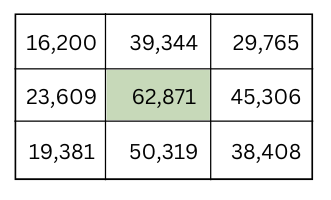
Answer: The digits ‘6’ and ‘1’ in 62,871 can be swapped to form the number 12,876.
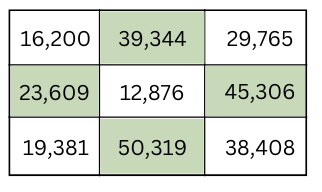
2. How many rounds does your year of birth take to reach the Kaprekar constant?
Answer:
First Try:
Follow these steps:
Step 1: Take a 4-digit number.
Step 2: Make the largest number from these digits. Call it A.
Step 3: Make the smallest number from these digits. Call it B.
Step 4: Subtract B from A. Call it C. C = A – B
Step 5: Continue doing this until you reach 6174 (Kaprekar constant).
Number = 1990
First Try:
A = 9910
B = 199
C = A – B = 9910 – 199 = 9711
Second Try:
A = 9711
B = 1179
C = A – B = 9711 – 1179 = 8532
Third Try:
A = 8532
B = 2358
C = A – B = 8532 – 2358 = 6174
Therefore, it took three tries to reach the Kaprekar constant i.e. 6174.
Note: Although not mentioned in the problem, it is easy to see that the series is a Collatz sequence:
The rule is: one starts with any number; if the number is even, take half of it; if the number is odd, multiply it by 3 and add 1; repeat.
1990, 995, 2986, 1493, 4480, 2240, 1120, 560, 280, 140, 70, 35, 106, 53, 160, 80, 40, 20, 10, 5, 16, 8, 4, 2, 1
3. We are the group of 5-digit numbers between 35,000 and 75,000 such that all of our digits are odd. Who is the largest number in our group? Who is the smallest number in our group? Who among us is the closest to 50,000?
Answer:
We are the group of 5-digit numbers between 35,000 and 75,000 such that all of our digits are odd.
The largest number in our group is 73,999.
The smallest number in our group is 35,111.
The number closest to 50,000 is 51,111.
4. Estimate the number of holidays you get in a year including weekends, festivals and vacation. Then try to get an exact number and see how close your estimate is.
Answer:
Number of weeks in a year = 52.
Number of weekend holidays = 52 × 2 = 104.
Number of festival holidays = 30
Number of summer vacation holidays = 30
Number of winter vacation holidays = 15
Total number of holidays = 104 + 30 + 30 + 15 = 179
Total number of holidays was found to be exactly 185.
Hence, we conclude that our estimate was very close.
5. Estimate the number of liters a mug, a bucket and an overhead tank can hold.
Answer:
A mug holds approximately 0.5 liters.
A bucket holds approximately 15 liters.
An overhead tank holds approximately 900 liters.
6. Write one 5-digit number and two 3-digit numbers such that their sum is 18,670.
Answer:
5-digit number: 18,000
3-digit number = 300
3-digit number = 370
Sum = 18,000 + 300 + 370 = 18,670
7. Choose a number between 210 and 390. Create a number pattern similar to those shown in Section 3.9 that will sum up to this number.
Answer:
The pattern is shown below:
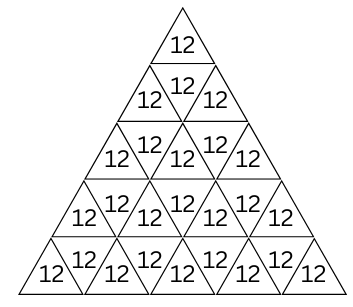
8. Recall the sequence of Powers of 2 from Chapter 1, Table 1. Why is the Collatz conjecture correct for all the starting numbers in this sequence?
Answer:
The rule is: one starts with any number; if the number is even, take half of it; if the number is odd, multiply it by 3 and add 1; repeat. The sequence should always reach 1.
The Collatz conjecture is correct for all the starting numbers in this sequence: 1, 2, 4, 8, 16, 32, 64, … because each time you divide by 2 you get an even number, until you reach 1.
9. Check if the Collatz Conjecture holds for the starting number 100.
Answer:
Starting number = 100 (even)
Therefore, 100/2 = 50
Next number = 50 (even)
Therefore, 50/2 = 25
Next number = 25 (odd)
Therefore, 25 × 3 + 1 = 76
Next number = 76 (even)
Therefore, 76/2 = 38
Next number = 38 (even)
Therefore, 38/2 = 19
Next number = 19
Therefore, 19 × 3 + 1 = 58
Next number = 58 (even)
Therefore, 58/2 = 29 (odd)
Next number = 29
Therefore, 29 × 3 + 1 = 88
Next number = 88 (even)
Therefore, 88/2 = 44
Next number = 44
Therefore, 44/2 = 22 (even)
Next number = 22
Therefore, 22/2 = 11 (odd)
Next number = 11
Therefore, 11 × 3 + 1 = 34 (even)
Next number = 34
Therefore, 34/2 = 17 (odd)
Next number = 17
Therefore, 17 × 3 + 1 = 52 (even)
Next number = 52
Therefore, 52/2 = 26 (even)
Next number = 26
Therefore, 26/2 = 13 (odd)
Next number = 13
Therefore, 13 × 3 + 1 = 40 (even)
Next number = 40
Therefore, 40/2 = 20 (even)
Next number = 20
Therefore, 20/2 = 10 (even)
Next number = 10
Therefore, 10/2 = 5 (odd)
Next number = 5
Therefore, 5 × 3 + 1 = 16 (even)
Next number = 16
Therefore, 16/2 = 8 (even)
Next number = 8
Therefore 8/2 = 4 (even)
Next number = 4
Therefore, 4/2 = 2 (even)
Next number = 2
Therefore, 2/2 = 1
Therefore, it is proved that the Collatz Conjecture holds for the starting number 100.
10. Starting with 0, players alternate adding numbers between 1 and 3. The first person to reach 22 wins. What is the winning strategy now?
Answer:
The winning strategy is as follows:
We have to find a position from which the opponent cannot win, which can be called a losing position.
A losing position is a total from which no matter what number (1, 2, or 3) your opponent adds, they cannot stop you from reaching 22 first.
To identify losing positions, we start backward from 22.
18 is a losing position, because from 18, any move (whether 1, 2 or 3 is added) your opponent makes (at 19, 20, or 21) leaves you in control of the game because you can just add 3, 2 or 1 respectively and reach 22.
Continuing this process, we find the other losing positions and force our opponent to land on these positions.


